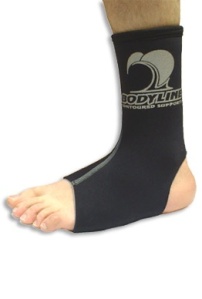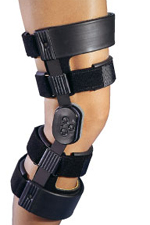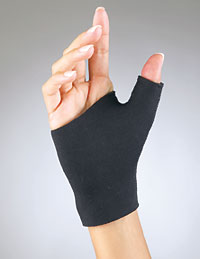A doctor discusses ACL Laxity and Knee Braces. The ACL is the duct tape in the knee that holds the big thigh bone (femur) to the leg bone (tibia). It stabilizes (along with the PCL) the knee in a front-back direction. A knee brace can be used to help the ACL. An ACL knee brace allows the knee to flex and extend while holding the thigh and leg bones in alignment. However,is there a better way than wearing a knee brace all the time? Knee surgeries to replace or reconstruct the ACL should only be performed (in my opinion) if the ACL is completely gone. if the ACL is just lax, an older method of treatment is prolotherapy. This is the injection of a substance to tighten the ligament. Reeves has shown that the ligament can be tightened in this way using monthly shots for about 6 months. Newer options already being performed in the US include seeding the patient’s own adult stem cells onto the ACL ligament to repair the damage. This only works if there are ACL fibers left to seed. Eventually, this same technique may be used to inject an ACL scaffold material into the knee with adult stem cells that can create a ligament. So if you have a stretched ACL and you’re using a knee brace for ACL laxity, investigate some of the injections that can help you loose the brace!
January 22, 2009
January 11, 2009
Prolite Thumb Support
As a doctor, thumb braces such as the “Prolite Thumb Support” can help provide an additional sense of stability. However, have you ever wondered if your thumb arthritis could be fixed without surgery by repairing the painful joint? Is this possible? New advances in using the patient’s own stem cells mean that a simple injection might help the thumb without the need for invasive surgeries. Since a video is worth a few thousand words, here are some for more information. The link above has more information as well.
Plantar Fasciitis Foot Brace
As a doctor, I have seen many patients have a difficult time understanding plantar fasciitis. Think of the plantar fascia as a piece of duct tape that travels along the bottom of your foot from your heel to the bottom of your toes. It’s job is to support the normal arch in your foot, especially when you put weight on the foot. As this piece of duct tape (plantar fascia) gets too much stress (due to extra weight on the person or too much force from changes in the way the foot moves), the heel area where it attaches can get easily overloaded and become painful. A plantar fasciitis foot brace is therefore simple, it’s something that helps reduce the extra stress on the duct tape. However, rather than bracing the plantar fascia, we often find that it’s much more effective to fix the problem. How? We strengthen the duct tape! That can be as simple as taking the patients own adult stem cells and injecting them into the heel area under x-ray guidance (we numb the area first so it’s not uncomfortable). This allows that heel anchor point to become much stronger and the pain to go away. Click on the link about to learn more about this type of procedure.
January 10, 2009
athletic ankle supports

As a doctor with an ankle problem, who is athletic, the best ankle brace I’ve found is the Malleoloc. However, if you have an ankle problem like I did, why not ditch the ankle supports? There are now new treatments where they inject your own stem cells into the ankle ligament tears to heal the damage. This way you avoid athletic ankle supports and surgery! This procedure should allow you to get rid of the athletic ankle supports for good. In this minor procedure, your own adult stem cells are grown to larger numbers. These repair cells are then injected into your torn ankle ligaments. After this cutting edge procedure, you can wear an athletic ankle support for a few weeks, but continue working out while the ligaments mend. You get to ditch the athletic ankle supports after just a month. Why do these injections instead of supports? An unstable ankle eventually damages the cartilage in the ankle and leads to early arthritis. So what’s a little ankle pain now, will be an arthritis problem in the future, unless you heal the ankle ligaments.
Ankle support in london?
As a physician, you might say that I have an American MD specializing in Regenerative Medicine and a “doctorate of hard knocks” in ankle braces. When I came across people searching for “Ankle support in london” I had to throw in my two cents. I don’t live in London, far from it, I’m in beautiful Boulder, Colorado. If you’re looking for an ankle support brace, I can tell you first hand that I’ve tried them all. The winner? The Malleoloc. However, my quest for the perfect ankle support didn’t end there, I then tried prolotherapy which allowed me to get rid of the ankle support brace. This technique involves injecting substances into the ankle ligaments to kick off an inflammatory healing response. This worked pretty well, even allowed me to take a run every once in a blue moon. What would I do today instead of the ankle support? I’d try this cutting edge procedure where they inject your won stem cells into the ankle ligaments to heal and repair the damage. The video below shows a patient where this was done in the U.S.:
December 24, 2008
Sports Ankle Brace
Several years ago I injured my ankle while running. It didn’t completely heal, so as a physician, I set out to find the perfect sports ankle brace. My first stop was the then famous “air cast”. This was a great way to stop the circulation in my ankle, but did little to help the pain and swelling. The next sports ankle brace I tried was the old fashioned lace-up models. They were a nightmare to get on and off, but did supply some stability. After trying 10-12 braces, I finally settled on something that worked, the Bauerfeind Malleoloc. This was an easy sports ankle brace to get on and off and actually provided some stability. Alas, after walking around with this thing for years, I finally decided to get the ligaments fixed using prolotherapy. This worked reasonably well and took a few injections. Today there are even newer ways to fix these ligaments with the injection of stem cells. The video below will provide more information:
August 28, 2008
Shoulder Surgery Recovery
As a doctor, because we use our upper extremities for everything, shoulder surgery recovery can be very difficult. Have you seen someone walking around in a sling with a big blue pillow between their arm and chest? Shoulder joint replacement surgery is notorious for a long, painful recovery. Rotator cuff surgery is also a very long and tough recovery, mostly because the stitches placed into the tendon must be kept immobile while the tear heals. So why all this suffering? Is there a better way? This post will explore if shoulder surgery recover from a rotator cuff tear can be shortened and if there is an alternative to shoulder joint replacement surgery.
The rotator cuff is simply a group of muscles that help to stabilize the shoulder. Think of them as the muscles that help keep the ball of the shoulder in it’s shallow joint while allowing for maximum alignment and mobility. When one of these muscles and/or their tendons (like the supraspinatus) gets torn, it’s a big problem. Patients often can’t lift their arm and have pain with any movement. This can be diagnosed on an MRI. If the tear is small, then sometimes it’ll heal on it’s own with therapy. However, many partial and complete tears fail to heal. When this happens, the traditional treatment is simply sewing up the tear and immobilizing the area. This is where the recovery problems begin. Immobilizing the shoulder is tough. Hence the crazy blue pillow shown below:
What happens when you immobilize the muscle for this long? Regrettably, it often causes to atrophy. This means the muscle starts to die off and this atrophy is associated with a poor outcome. How can you get around this atrophy? How about skipping the immobilization? Can you do this? Yes, the Regenexx procedure allows patients with partial rotator cuff tears to shorten their shoulder surgery recovery. Why, because it starts by skipping the surgery step. In this breakthrough procedure, your adult stem cells are injected into the rotator cuff tear under fluoroscopy (real time x-ray). Less trauma to fix the tear means less recovery. In addition, unlike simply sewing the tear and hoping for the best, the joint preservation team at The Center for Regenerative Medicine at the Centeno-Schultz Clinic places repair cells in the tear.
Check out the MRI pics above. Stem cells placed into the tear helped the tear heal without surgery. So if you want to avoid a lengthy recover with a crazy blue pillow, trade the surgery for a needle!





